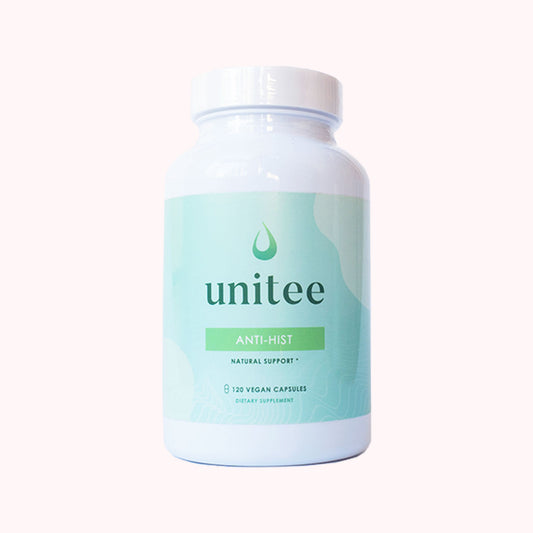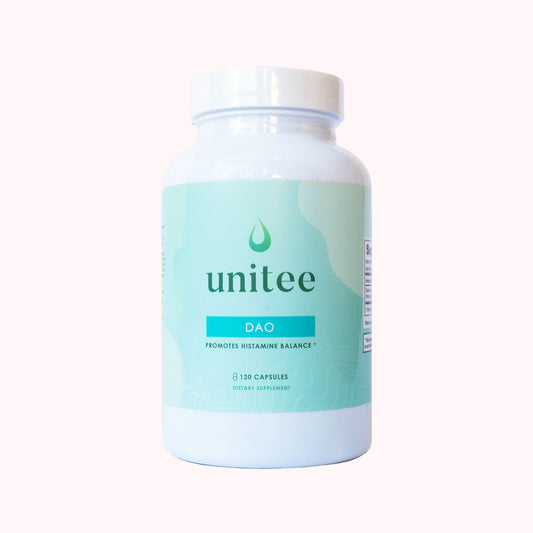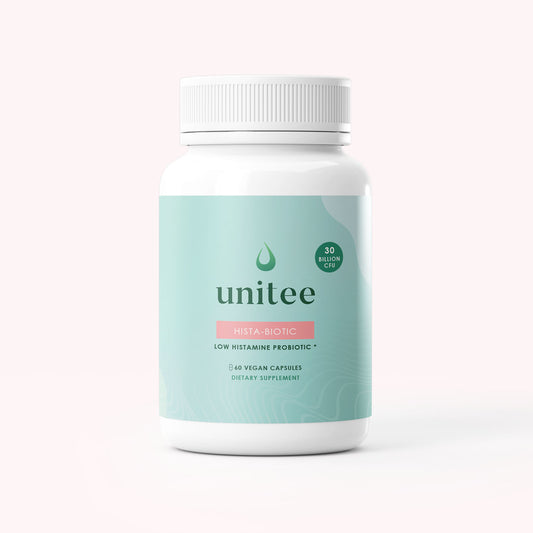When you’re living with histamine intolerance, it can be hard to navigate your diet… even when you’re armed with one of the best and most comprehensive lists showing you exactly what to include and avoid when following a low histamine diet!
Not only is it sometimes impossible to account for every histamine triggering compound in your food, you may also have to worry about a number of other factors that could bring on histamine symptoms. One of those is the possibility that even low histamine foods could cause histamine intolerance symptoms, simply because of the way the food is processed or how your body reacts to certain manufacturing processes.
One of those foods that gets a lot of questions is guar gum!
I see a lot of people reacting to guar gum as an ingredient. But that’s downright confusing because guar gum is actually not a naturally high histamine food. So what gives?
Well, today I’m going to give you the insight you need to be able to navigate this common food source. And you’ll discover why it might be causing your body to develop these bothersome histamine symptoms when it really shouldn’t.
First, let’s take a quick look at what guar gum is so you may understand where it may creep into your diet…
Guar Gum and Its Role in the Food Industry
Gums are commonly used in the food industry to thicken and stabilize foods. Guar gum is one of them often used because of its galactomannan polysaccharide properties (1). It’s added to things like soups, stews and dairy products to ensure they have a nice rich and smooth texture.
While it usually gets a bad rap, guar gum is a natural extract from the humble guar bean, which is dehusked, dehydrated and milled to produce the powdered gum. It’s a great source of soluble fiber, forming a gel-like consistency when it comes into contact with liquid. Soluble fiber is well known for its effect on the digestive system, slowing it down to enhance absorption or reduce diarrhea. Guar gum is also a naturally gluten-free product, which is another property making it a versatile addition to many foods.
Guar gum has another important role in the medical industry: it’s added to medication to ensure a slowed release due to the fibre-rich properties I mentioned above. But this is also one of the reasons guar gum histamine can contribute to the symptoms of histamine intolerance.
Understanding the Link Between Guar Gum Histamine and Reactions
If guar gum contains soluble fiber, and soluble fiber slows digestion down, and slowing digestion down increases the absorption of food compounds, what do you think is going to happen when you have guar gum combined with a food that contains histamine? Well, it may increase the body’s ability to absorb more histamine from that food, and thereby lead to an increase in the amount of histamine you have flowing around your body!
The trouble is, guar gum is typically used in processed foods. And even though they seem healthy, they may contain traces of histamine which sensitive people may react to. Essentially, guar gum may get blamed for the reaction, but it could be histamine itself having more time to enter the bloodstream, no matter how small the amount is. Of course, there’s also a risk of guar gum being contaminated by other chemicals in the manufacturing process, but the main reason people may think they’re reacting to it as an ingredient added to healthier foods is likely due to the slowing of digestion and higher absorption of histamine or histamine-triggering compounds.
It’s for this reason, if you do feel you’re sensitive to guar gum histamine, I suggest looking at the other ingredients in that food and determining whether there’s another culprit causing your symptoms.
Besides, there are some significant benefits related to good quality guar gum when it comes to histamine intolerance.
Here’s how guar gum can help histamine intolerance
We know a diet higher in fiber is essential to good gut health. It helps to maintain the smooth process of elimination of waste, and is important for keeping the little critters in the digestive tract happy and healthy. More importantly, fiber has been shown to support those living with histamine intolerance due to the effect it has on the mast cells located in the digestive tissue (2). These mast cells are an important mediator of food allergies as they’re essentially on the front line after the exposure to any food allergens directly after they’ve been eaten and picked up by the immune system (3).
Fiber, due to its role in producing short chain fatty acids - in particular, butyrate - can decrease the stimulation of mast cells to release histamine, thereby dampening the symptoms of immune-like reactions. What’s more, butyrate production as a result of fiber intake can dampen the production of one of the most significant inflammatory markers called TNF, which means many other symptoms of digestive and body-wide inflammation may be decreased (4).
While there are many different types of fibres available on the market, I find many people tolerate guar gum histamine quite well. In particular, a partially hydrolyzed type of guar gum, called PHGG. PHGG is available in a pure powdered format, which can be added to the diet as a fiber supplement. It can be easily added to any liquid food such as soups and smoothies or even plain water.
It has been shown to improve symptoms of gas, bloating and IBS-like symptoms even in individuals who have a significant amount of digestive inflammation (5).
It’s important to slowly introduce any additional fiber into the diet, even something as well tolerated as PHGG. If too much is added at once and the digestive system is not used to the amount of fiber, it can cause the opposite effects such as gas and bloating. Building up to a therapeutic level can reduce these negative effects and provide far more benefit in the long run.
Introducing Guar Gum Fiber Into Your Low Histamine Diet
So how exactly do you slowly introduce fiber? I’ve got you…
Week 1: Add ½ a tablespoon of fiber to 1 meal a day
Week 2: Add 1 tablespoon of fiber to 1 meal a day
Week 3: Add 1 tablespoon of fiber to 1 meal a day and another ½ tablespoon to a second meal
Week 4: Add 1 tablespoon of fiber to two meals a day
Remember to continue to keep an eye on your symptoms. Should you develop bloating, gas or any abdominal pain when increasing to the next levels of fiber, return to the previous amount and continue for another week before increasing.
Another important consideration is how much liquid you take in as you increase your fiber intake. As mentioned earlier, gums and fibers absorb water. Imagine what happens in your digestive system! Exactly. It will absorb water. If there’s not enough water, it’ll make your digestive waste very dry and difficult to eliminate. So we want to ensure we have enough water to lubricate the process. And 2.5-3L of water and/or plain herbal tea per day is ideal!
Now you know guar gum and histamine intolerance are a match made in heaven in the right settings. Consider where guar gum and other healthy fibers fit into your low histamine diet, and the benefit you may be able to reap by including them into your routine.
References:
1. Mudgil D, Barak S, Khatkar BS. Guar gum: processing, properties and food applications-A Review. J Food Sci Technol. 2014;51(3):409-418. doi:10.1007/s13197-011-0522-x
2. Ramsay DB, Stephen S, Borum M, Voltaggio L, Doman DB. Mast cells in gastrointestinal disease. Gastroenterol Hepatol (N Y). 2010;6(12):772-777.
3. Weston AP, Biddle WL, Bhatia PS, Miner PB Jr. Terminal ileal mucosal mast cells in irritable bowel syndrome. Dig Dis Sci. 1993;38(9):1590-1595. doi:10.1007/BF01303164
4. Folkerts J, Stadhouders R, Redegeld FA, et al. Effect of Dietary Fiber and Metabolites on Mast Cell Activation and Mast Cell-Associated Diseases. Front Immunol. 2018;9:1067. Published 2018 May 29. doi:10.3389/fimmu.2018.01067
5. Abe A, Morishima S, Kapoor MP, et al. Partially hydrolyzed guar gum is associated with improvement in gut health, sleep, and motivation among healthy subjects. J Clin Biochem Nutr. 2023;72(2):189-197. doi:10.3164/jcbn.22-75

Anita Tee
My name is Anita Tee. I'm a nutritional scientist who specializes in histamine intolerance. I hold a Master of Science in Personalized Nutrition and a Bachelor of Science in Human Biology and Psychology.
For the past ten years, I have used my experience in nutritional and medical health sciences to create a scientifically backed, natural approach to healthcare that relies 100% on evidence-based research.
As I previously suffered from - and overcame - histamine intolerance, my focus is to increase recognition and expand the available resources and protocols available for resolving this particular disorder. To date, I have helped over 4,000 individuals fully resolve or better manage their histamine intolerance symptoms.







